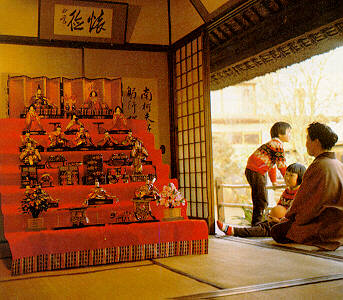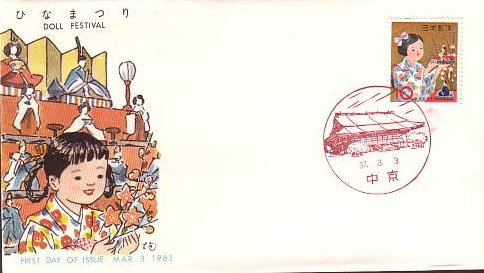
Japan in March
March 1-14: Todai-ji Temple:Nara-shi , Nara
This is part of the monks training program known as shunie. On the night of the 12th the monks light large torches and wave them around from the temple's gallery. Following that a ceremony is performed in which water is drawn from a well.
March 3: Hina Matsuri

This is also referred to as the Doll Festival, Peach Festival or Girl's Festival. People pray for the happiness and healthy growth of girls and families with young daughters set up a display of dolls inside the house.The tradition goes back to the Edo Period (1603-1868).
The dolls wear costumes of the imperial court during the Heian period (794-1192) and are placed on a platform with various tiers of five to seven layers.
The top tier is for the Emperor and Empress. A miniature gilded folding screen is placed behind them as it was in the real court. The second tear has three ladies-in-waiting. The third has five male court musicians; the fourth has ministers sitting on either side of trays of food; the fifth has guards with an orange tree on the left and a cherry tree on the right.
The family celebrates with a special meal of diamond-shaped rick cakes and shirozake which is rice malt with sake.
The dolls are returned to their storage space after the festival is over since there is a superstition that families that are slow in putting the dolls away will have difficulty in marrying off their daughters.

March 6: Utsu-ue Matsuri
At Yatsufusa-jinja Shrine, Kushikino-shi, Kagoshima, a rice-planting festival with a dance performed by men wearing ox masks.
March 12: Water-Drawing Festival
This is held at Todiji, Nara and is one of the most famous fire festivals in Japan. At midnight priests carry large torches to mark the drawing of the sacred water from the Wakasa well below Nigatsudo.
May 13:Kasuga-taisha Shrine
The Kasuga-taisha Shrine: Nara-shi, Nara holds its spring festival on this date. There is a horse ceremony involving a sacred horse being led into the shrine precincts. There is also a special dance performed called the Yamato-mai.
The shrine itself dates back to the 8th century. Just as a matter of general interest this makes the shrine about seven centuries older than the "discovery" of the U.S.
March 14: White Day
This is one of the holidays basically invented by business. A company that made marshmallows started a campaign in 1965 urging men to repay the woman they got valentine's chocolate from with their soft, fluffy marshmallows. The term White Day came from the color of the candy.
Gradually other candy makers got into the act, the marshmallows were dropped, and men were encouraged not to just give candy but also to give gifts like women's handkerchiefs.
March 17: Fujimori-no-Taasobi
This is a special rice-planting festival at Oihachimangu Shrine, Oigawa-cho, Shizuoka. It features 27 different dances and dates back to around a thousand years ago.
March 20 or 21: Shunbun no Hi: Vernal Equinox Day
This is the day that the sun crosses the equator and the length of night and day becomes equal. It is basically a day to show affection for all living things.
Higan refers to the period of time three days before the vernal equinox to three days after it. During this time respects are paid to ancestors and visits are made to family graves to clean them and offer flowers and incense to ancestral spirits.
Late March: Graduation Ceremonies
The Japanese school year ends in March so this is a time of graduation ceremonies. Generally the principal opens with an address after which there are speeches from guests. Certificates are given individually to the students. After they receive their certificates the students sing Hotaru no hikari (light of fireflies).

|